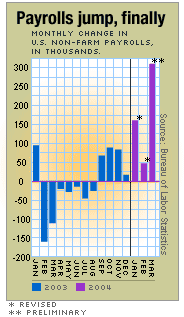NEW YORK (CNN/Money) -
Is the jobless part of the jobless recovery over? Friday's April employment report will go a long way to answering that question.
It's an important question not only for employers and job seekers, but for investors. Signs that the job market is truly back in gear could give the Federal Reserve the cover it needs to raise interest rates as soon as its June meeting.
The increased likelihood of higher rates is one reason that stock and Treasury bond prices fell Thursday after the morning's weekly jobless claims report showed fewer people filed initial claims last week than any time since late 2000.
Traders at the Chicago Board of Trade Thursday were betting on a 56 percent chance the Fed would raise its key short-term rate a quarter point at the June meeting, up from just a 42 percent chance after the Fed meeting on Tuesday.
In addition to worries about rising rates, soaring oil prices also sent stocks lower Thursday. The drop in bond prices pushed the yield on the 10-year Treasury as high as 4.61 percent -- the highest in 22 months -- from 4.58 percent late Wednesday. Bond prices and yields move in opposite directions.
Looking for a trend
But last week's jobless claims won't impact the April employment report, which covers the last half of March and the first half of April. And economists are widely split on the key number in the report -- the number of new jobs added by employers. Reuters found a range of estimates from 60,000 to 250,00 new jobs among economists surveyed.

The unemployment rate is expected to stay unchanged at 5.7 percent, with a much tighter range of estimates -- the economists surveyed came in with either a 5.6 percent or 5.7 percent rate.
What they're looking for is a sign of whether the strong March employment report -- when 308,000 jobs were added -- was the start of something big or just a big tease.
Wachovia Securities economist Mark Vitner is in the start-of-something big camp. He believes we could see more than 280,000 jobs added virtually every month through the rest of this decade. He's forecasting an April report with 240,000 jobs added, and a significantly bigger number in the May or June report.
"The jobless recovery is well behind us," said Vitner. "The economy right now is not really in a recovery mode, it's in a boom mode. Companies are going to be hiring out of fear if they don't, they lose an opportunity to make more money."
Vitner said the relatively low number of jobless claims is one of the things giving him confidence that the employment picture is seeing significant, permanent improvement.
But other economists are not as convinced.
Drew Matus, senior economist at Lehman Brothers, said his firm is looking for only about 150,000 jobs to be added in the April report, a bit below the 173,000 consensus number from Reuters.
"We're inclined to look at last month's number as the aberration and not the new trend," he said. "We think some catch-up to past months was involved. We think what we're likely to see is more measured growth."
Taking the somewhat middle ground is Steven Wieting, senior economist at Citigroup. His firm has a relatively bullish forecast of 250,000 jobs added in the April report, but he doesn't necessarily look for that level to be sustained month after month.
"We think that employment has been fundamentally improving for some time now," he said.
"The exaggerated weakness we saw in winter months suggests an above-trend gain in the April report. But that doesn't necessarily mean we will see non-stop persistent gains at this level. We're looking for something more like the monthly average of 171,000 we saw added through the first quarter."
That level of growth is slightly better than the 150,000 or so new jobs needed to keep pace with population growth. But it's a far cry from the strong job growth seen in past recoveries.
Even after Friday's report there will be some debate about the long-term outlook for employment. But given the number's importance, the report is subject of an unusually high level of scrutiny.
"If it's high, they (investors) get confirmation that the 300,000 was a good number. We have two data points rather than just one," said Matus.
Fed more focused on inflation
Wieting, Matus and Vitner agree on one thing -- that the reports on retail and wholesale prices are probably more important to predicting when the Fed will raise rates than either the April or May jobs report the Fed will see before its next meeting in June.
The April producer price index, which measures wholesale prices, is due Wednesday while the April consumer price index, which measures prices paid by consumers, is due Friday. Those numbers, as well as other inflation measures, are a better sign of whether the Fed will raise rates in June or wait until its August or September meeting.
"I think people are too focused on jobs," said Matus. "If you ask the members of the Fed what's the best environment for creating jobs, they'd all say a low inflation environment. They will take long-run price stability over short-term job growth."
But investors trying to gauge the Fed's path are likely to react strongly to the jobs data, particularly if it is well below or well above the consensus forecast of 173,000 additional jobs from Reuters.

|


